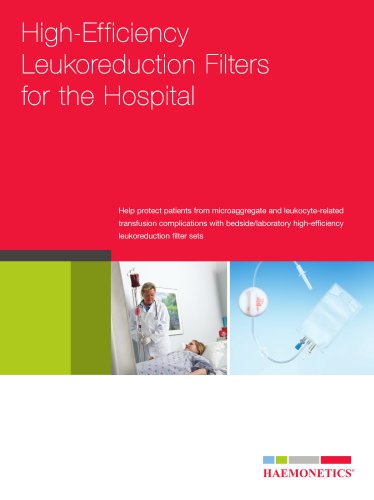
カタログの抜粋

Introducing WHITE PAPER This white paper presents the TEG 6s device, a revolutionary approach to viscoelastic hemostatic assays (VHAs) science by the introduction of an innovative, all-in-one cartridge. The TEG system is a real-time analyzer of whole blood measuring the viscoelastic properties of the hemostasis process and allowing for individualized goal-directed therapy. It provides rapid, comprehensive and accurate identification of an individual’s hemostasis condition, in a laboratory or in the context of near-patient testing, which allows clinicians to drive personalized, clinically and economically sound treatment and monitoring decisions. The demonstrated benefits of using TEG: In cardiac surgery, TEG allows a reduction in blood product usage by providing clinicians with information to help determine which specific blood products are needed to stop bleeding, and accurately identifies the need for re-operations by ruling out a coagulopathic cause of bleeding. For patients on antiplatelet medications, TEG helps to stratify bleeding risk and reduce time to schedule coronary artery bypass graft (CABG) surgery and length of stay. TEG is more predictive than conventional coagulation tests (CCTs) in anticipating massive transfusion, delivers results faster for trauma physicians and guides specific blood products and ’high risk’ drugs to stop bleeding in trauma patients and predicts those at high risk of pulmonary embolism (PE). (3-8) TEG helps to stratify risk of thrombotic events by helping clinicians determine which patients are at risk of thrombotic events and to determine the effectiveness of P2Y12 agonists. TEG helps to stratify risk of deep vein thrombosis and PE in ICU patients and improves adequate use of expensive pharmaceuticals (rFVIIa, fibrinogen).
カタログの1ページ目を開く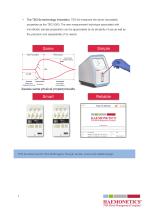
■ The TEG 6s technology innovation. TEG 6s measures the same viscoelastic properties as the TEG 5000. The new measurement technique associated with microfluidic sample preparation can Pe appreciated by its simplicity of use as well as the precision and repeatability of its results. Same ^^^^^^H Simple Assess same physical property/results THE Blood Management Company
カタログの2ページ目を開く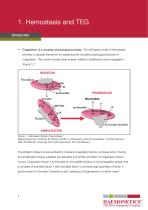
Coagulation is a complex physiological process. The cell-based model of hemostasis provides a valuable framework for explaining the complex physiological process of coagulation. The model includes three phases: initiation, amplification and propagation (Figure 1).(1) Figure 1. Cell-based model of hemostasis.1 [Reproduced from Hoffman M, Monroe III DM. A cell-based model of hemostasis. Thromb Haemost 2001;85:958–65. Copyright 2015 with permission from Schattauer] The initiation phase involves activation of several coagulation factors via tissue factor. During the amplification phase,...
カタログの3ページ目を開く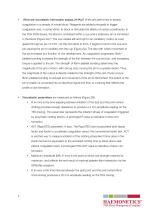
What are viscoelastic hemostatic assays (VHAs)? VHAs are performed to assess coagulation in a sample of whole blood. Reagents are added principally to trigger coagulation and, in some VHAs, to block or stimulate the effects of certain constituents. In the TEG 5000 device, the blood is contained within a cup and a stationary pin is immersed in the blood (Figure 2A).(2) The cup rotates left and right in an oscillatory motion at a set speed through an arc of 4°45’. As the clot starts to form, it begins to bind to the cup and pin causing the pin to oscillate with the cup (Figure 2A). The rate...
カタログの4ページ目を開く
α angle (in °) is the angle formed by the slope of a tangent line from the tracing at the midpoint between the R and the K time. The K and α angle parameters reflect the rate of clot formation or the cleavage of fibrinogen into fibrin mediated by thrombin. LY30 (%) is the percentage reduction in amplitude 30 minutes after reaching MA. After the clot has formed, it is degraded by fibrinolytic factors within the blood and the amplitude decreases over time. By measuring the extent/speed of amplitude reduction, clot lysis can be assessed. Figure 2. The principles by which TEG functions. A....
カタログの5ページ目を開く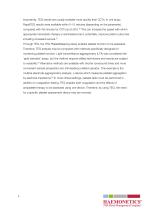
Importantly, TEG results are usually available more quickly than CCTs. In one study, RapidTEG results were available within 5–15 minutes (depending on the parameter), compared with 48 minutes for CCTs (p<0.001).(5) This can increase the speed with which appropriate hemostatic therapy is administered and, potentially, improve patient outcomes including increased survival.(7) Through TEG, the TEG PlateletMapping assay enables platelet function to be assessed. Therefore, TEG analysis may be compared with methods specifically designed for monitoring platelet function. Light transmittance...
カタログの6ページ目を開く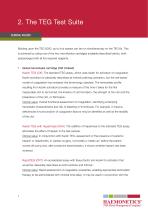
2. The TEG Test Suite CLINICAL VALUES Building upon the TEG 5000, up to four assays can be run simultaneously on the TEG 6s. This is achieved by using one of the two microfluidics cartridges available (described below), both prepackaged with all the required reagents. Global hemostasis cartridge (CM citrated) Kaolin TEG (CK). The standard TEG assay, which uses kaolin for activation of coagulation. Kaolin activation is classically described as intrinsic pathway activation, but the cell-based model of coagulation has rendered this terminology obsolete. The hemostasis profile resulting from...
カタログの7ページ目を開く
Functional Fibrinogen assay to pinpoint fibrinogen or platelet deficiency, and the impact of the ratio of platelets and fibrin to the resulting clot strength. TEG Functional Fibrinogen (CFF). Tissue factor is used for coagulation activation that would be classically described as extrinsic, with platelet function inhibited by a GPIIb/IIIa inhibitor such that the resulting contribution of the functional fibrinogen to clot strength is exhibited. By subtracting this functional fibrinogen contribution from the overall clot strength, the specific contribution of platelet function is extrapolated....
カタログの8ページ目を開く
increased thrombosis risk. In trauma, ADP responsiveness has been correlated with a patient’s need for transfusion. TEG 6s cartridges Simple. The assays described above are performed on TEG 6s using one of two microfluidic cartridges (see section 5), each of which has four analysis channels utilizing minimal blood volumes of 300 μL for all four channels (Table 1). Cartridge Sample type Kaolin TEG with heparinase (HKH) Platelet mapping Kaolin TEG with heparinase (CKH) Global hemostasis AA Table 1. Configuration of TEG 6s cartridges. The TEG 6s cartridges enable multiple assays to be run...
カタログの9ページ目を開くHAEMONETICSのすべてのカタログと技術パンフレット
-
NexSys PCS
6 ページ
-
MCS®+ 9000
4 ページ
-
cell saver Ellite+
8 ページ
-
Acrodose PL Systems
2 ページ
-
MCS+ 8150
4 ページ
-
Blood Track
12 ページ
-
SafeTrace Tx
4 ページ
-
MCS®+8150
4 ページ
-
EdgeBlood
4 ページ
-
PCS 2
4 ページ
-
Cell Saver Elite
4 ページ
-
MCS®+
4 ページ
-
ACP ® 215
4 ページ
-
TEG ® 5000
8 ページ
カタログアーカイブ
-
eDonor
2 ページ
-
Cell Saver ® 5+
8 ページ
-
EdgeCell
4 ページ
-
Donor Doc Phlebotomy
2 ページ
-
Donor Doc
4 ページ
-
ElDorado Control
4 ページ
-
ElDorado Donor
4 ページ
-
Surround
2 ページ
-
OrthoPAT
4 ページ
-
cardioPAT ®
8 ページ




